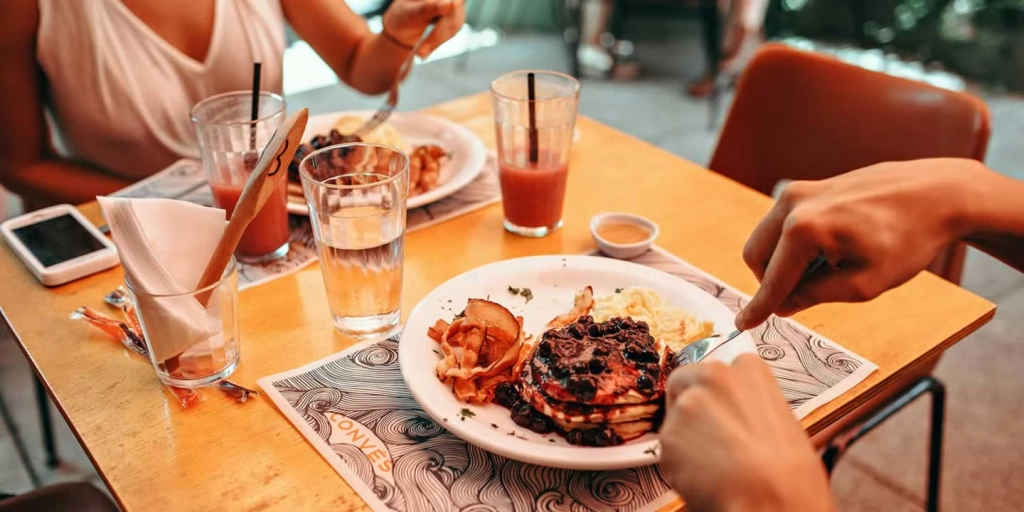
Stomach pain after eating can be a cause for concern, especially if it happens frequently. Learn more about treating frequent and occasional stomach pain.
Potential Causes and Treatments
Stomach pain after eating, also called post-prandial abdominal pain, can result from various conditions ranging from mild to severe. Some of the most common causes include:
- Indigestion (dyspepsia): Often felt as a burning sensation in the stomach or upper abdomen, indigestion can happen when you eat too fast or too much, consume high-fat, spicy, acidic, or greasy foods, or eat under stressful conditions. Some medications can cause indigestion, including certain antibiotics and anti-inflammatories. Health conditions such as gastritis or H. pylori infections can also cause indigestion.
- Treatment: If an infection like Helicobacter pylori (H. pylori) is causing the pain, a provider will likely prescribe some type of antibiotic. Other treatments for indigestion generally include over-the-counter antacids and lifestyle modifications such as less alcohol or fizzy drinks or eating smaller, more frequent meals.
- Food Intolerance or Allergy: If you experience stomach pain after eating certain foods such as lactose or gluten, it’s a sign you could have a food intolerance or allergy. A common one is celiac disease.
- Treatment: The best treatment is to avoid the triggering foods and possibly work with a healthcare provider to identify these triggers through testing.
- Gastroesophageal Reflux Disease (GERD): If you’re experiencing GERD, you’ll often experience not only a stomach-burning sensation or pain after eating but also a sour taste in your mouth. That’s because GERD allows stomach acid to flow back into the esophagus.
- Treatment: There is no cure for GERD, but dietary changes, weight management, and antacids can help manage symptoms
- Peptic Ulcers: These ulcers are sores on the lining of your stomach or small intestine, often caused by an H. pylori infection or long-term use of nonsteroidal anti-inflammatory drugs (NSAIDs). Treatment
- Treatment: Treatment plans for peptic ulcers include antibiotics, acid-reducing medications, and changing medications that might be causing the ulcers.
- Irritable Bowel Syndrome (IBS): This condition can cause cramping, bloating, gas, diarrhea, and constipation. Usually, medical providers watch for a specific pattern of symptoms and perform other tests to rule out other health conditions.
- Treatment: There’s no cure for IBS, so healthcare providers recommend dietary changes, stress management, probiotics, and, in some cases, medications are required to control the symptoms.
- Chronic Pancreatitis: Pancreatitis is inflammation of the pancreas and can cause severe, sudden pain in the upper stomach that radiates to the back. The pain can often become worse after eating. Causes of pancreatitis include gallstones, heavy alcohol use, genetic disorders, and some medications.
- Treatment: Treatment sometimes requires hospitalization, where you receive fluids, pain relievers, and sometimes surgery or other procedures. Sometimes, vitamins and enzyme pills can help with digestion.
- Gallstones: If you’re experiencing upper stomach pain after eating, it could be a sign of gallstones. Gallstones can block the ducts of the gallbladder, causing sharp pain in the upper right quadrant of your abdomen. Other symptoms include nausea, vomiting, fever, chills, jaundice, and tea-colored urine. Having too much cholesterol or bilirubin or not enough bile salts can cause gallstones
- Treatment: Treatment options include medications to dissolve gallstones or surgery to remove the gallbladder altogether.
Upper Stomach vs. Lower Stomach Pain
The location of your stomach pain can offer clues about what’s wrong. Pain in your upper stomach, mainly if it’s also burning, may be related to ulcers, gastritis, or GERD. If you’re feeling pain in your lower abdomen, it could be related to issues in the lower gastrointestinal tract, such as IBS or, in some cases, appendicitis.
What To Do If Other Symptoms, like Diarrhea, Accompany the Stomach Pain
If you experience stomach pain and diarrhea after eating, it could indicate a gastrointestinal infection, food intolerance, or IBS. Managing this involves staying hydrated, eating bland foods like bananas, rice, and toast, and avoiding caffeine and spicy foods. See a medical provider if symptoms persist, as you may need specific treatments or tests.
What Do I Do If My Stomach Pain After Eating is Frequent?
If your post-prandial abdominal pain is frequent or recurring, don’t ignore it. This pattern can signify a chronic condition like an ulcer, GERD, or gallstones. It’s crucial to monitor your symptoms and consult a healthcare provider who can offer a diagnosis and appropriate treatment plan based on thorough examinations and possibly some tests like an ultrasound or endoscopy.
When Do I Need to See a Medical Provider?
You should seek immediate medical attention if your stomach pain eating is severe and comes with fever, vomiting, blood in stool, jaundice, or severe tenderness when you touch your abdomen. These could be signs of more serious conditions like pancreatitis, stomach perforation, or a gallbladder attack.
Home remedies and over-the-counter medications might suffice in mild cases of stomach pain after eating. However, if the pain is persistent or if you’re experiencing stomach pain and diarrhea after eating regularly, you should consult with a healthcare professional.
If you’re concerned about your symptoms or it’s disrupting your life, the local healthcare providers at American Family Care are ready to help. With our extended evening and weekend hours, you can conveniently fit a visit into your schedule to find some answers to your stomach pain. No appointment is needed; just walk in.
Find a location near you.
